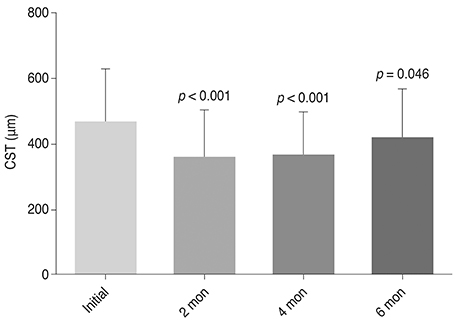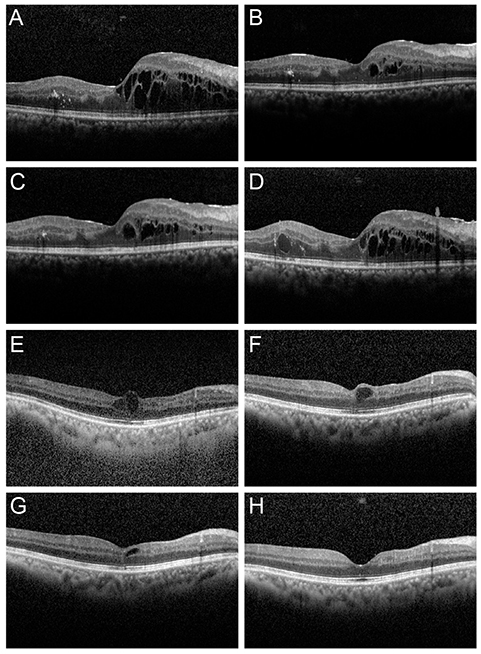Korean J Ophthalmol.
2016 Feb;30(1):25-31. 10.3341/kjo.2016.30.1.25.
Effect of Posterior Subtenon Triamcinolone Acetonide Injection on Diabetic Macular Edema Refractory to Intravitreal Bevacizumab Injection
- Affiliations
-
- 1Department of Ophthalmology, Asan Medical Center, University of Ulsan College of Medicine, Seoul, Korea.
- 2Department of Ophthalmology, Gangneung Asan Hospital, University of Ulsan College of Medicine, Gangneung, Korea. jsg1105@gmail.com
- KMID: 2363887
- DOI: http://doi.org/10.3341/kjo.2016.30.1.25
Abstract
- PURPOSE
To evaluate the effects of posterior subtenon triamcinolone acetonide injection on refractory diabetic macular edema (DME) after intravitreal bevacizumab (IVB) injection failure.
METHODS
Patients with DME and central subfield thickness (CST) >300 microm who did not respond to IVB injections were retrospectively included. Specifically, we enrolled patients who were diagnosed with refractory DME and who experienced an increase in CST after 1 to 2 IVB injections or no decrease after > or =3 consecutive IVB injections. One clinician injected 20 mg of triamcinolone acetonide into the posterior subtenon space. All patients received ophthalmic examinations at baseline and at 2, 4, and 6 months post-baseline. Examinations included Snellen visual acuity, intraocular pressure, and spectral-domain optical coherence tomography.
RESULTS
Forty eyes of 34 patients were included. The average baseline CST was 476 microm. The average CST decreased to 368 microm at 2 months, 374 microm at 4 months, and 427 microm at 6 months (p < 0.001 for all results, Wilcoxon signed-rank test). The average intraocular pressure increased from 15.50 to 16.92 mmHg at 2 months but decreased to 16.30 mmHg at 4 months and 15.65 mmHg at 6 months. Logarithm of the minimum angle of resolution visual acuity improved from 0.56 to 0.50 at 2 months (p = 0.023), 0.50 at 4 months (p = 0.083), and 0.48 at 6 months (p = 0.133, Wilcoxon signed-rank test). No complications were detected.
CONCLUSIONS
Posterior subtenon triamcinolone acetonide is an effective and safe treatment for reducing CST in DME refractory to IVB.
MeSH Terms
-
Aged
Angiogenesis Inhibitors/*therapeutic use
Bevacizumab/*therapeutic use
Diabetic Retinopathy/diagnostic imaging/*drug therapy/physiopathology
Female
Glucocorticoids/*administration & dosage
Humans
Injections, Intraocular
Intraocular Pressure/physiology
Intravitreal Injections
Macular Edema/diagnostic imaging/*drug therapy/physiopathology
Male
Middle Aged
Retrospective Studies
Tenon Capsule/*drug effects
Tomography, Optical Coherence
Treatment Failure
Triamcinolone Acetonide/*administration & dosage
Vascular Endothelial Growth Factor A/antagonists & inhibitors
Visual Acuity/physiology
Angiogenesis Inhibitors
Bevacizumab
Glucocorticoids
Triamcinolone Acetonide
Vascular Endothelial Growth Factor A
Figure
Reference
-
1. Klein R, Klein BE, Moss SE, et al. The Wisconsin epidemiologic study of diabetic retinopathy. IV. Diabetic macular edema. Ophthalmology. 1984; 91:1464–1474.2. Early Treatment Diabetic Retinopathy Study research group. Photocoagulation for diabetic macular edema: early Treatment Diabetic Retinopathy Study report number 1. Arch Ophthalmol. 1985; 103:1796–1806.3. Thomas BJ, Shienbaum G, Boyer DS, Flynn HW Jr. Evolving strategies in the management of diabetic macular edema: clinical trials and current management. Can J Ophthalmol. 2013; 48:22–30.4. Mitchell P, Bandello F, Schmidt-Erfurth U, et al. The RESTORE study: ranibizumab monotherapy or combined with laser versus laser monotherapy for diabetic macular edema. Ophthalmology. 2011; 118:615–625.5. Brown DM, Nguyen QD, Marcus DM, et al. Long-term outcomes of ranibizumab therapy for diabetic macular edema. The 36-month results from two phase III trials: RISE and RIDE. Ophthalmology. 2013; 120:2013–2022.6. Martidis A, Duker JS, Greenberg PB, et al. Intravitreal triamcinolone for refractory diabetic macular edema. Ophthalmology. 2002; 109:920–927.7. Bakri SJ, Kaiser PK. Posterior subtenon triamcinolone acetonide for refractory diabetic macular edema. Am J Ophthalmol. 2005; 139:290–294.8. Jonas JB, Kreissig I, Sofker A, Degenring RF. Intravitreal injection of triamcinolone for diffuse diabetic macular edema. Arch Ophthalmol. 2003; 121:57–61.9. Sutter FK, Simpson JM, Gillies MC. Intravitreal triamcinolone for diabetic macular edema that persists after laser treatment: three-month efficacy and safety results of a prospective, randomized, double-masked, placebo-controlled clinical trial. Ophthalmology. 2004; 111:2044–2049.10. Yilmaz T, Weaver CD, Gallagher MJ, et al. Intravitreal triamcinolone acetonide injection for treatment of refractory diabetic macular edema: a systematic review. Ophthalmology. 2009; 116:902–911.11. Diabetic Retinopathy Clinical Research Network. A randomized trial comparing intravitreal triamcinolone acetonide and focal/grid photocoagulation for diabetic macular edema. Ophthalmology. 2008; 115:1447–1459.12. Elman MJ, Bressler NM, Qin H, et al. Expanded 2-year follow-up of ranibizumab plus prompt or deferred laser or triamcinolone plus prompt laser for diabetic macular edema. Ophthalmology. 2011; 118:609–614.13. Thach AB, Dugel PU, Flindall RJ, et al. A comparison of retrobulbar versus sub-Tenon's corticosteroid therapy for cystoid macular edema refractory to topical medications. Ophthalmology. 1997; 104:2003–2008.14. Jennings T, Rusin MM, Tessler HH, Cunha-Vaz JG. Posterior sub-Tenon's injections of corticosteroids in uveitis patients with cystoid macular edema. Jpn J Ophthalmol. 1988; 32:385–391.15. Toda J, Fukushima H, Kato S. Injection of triamcinolone acetonide into the posterior sub-tenon capsule for treatment of diabetic macular edema. Retina. 2007; 27:764–769.16. Choi YJ, Oh IK, Oh JR, Huh K. Intravitreal versus posterior subtenon injection of triamcinolone acetonide for diabetic macular edema. Korean J Ophthalmol. 2006; 20:205–209.17. Otani T, Kishi S, Maruyama Y. Patterns of diabetic macular edema with optical coherence tomography. Am J Ophthalmol. 1999; 127:688–693.18. Shimura M, Yasuda K, Yasuda M, Nakazawa T. Visual outcome after intravitreal bevacizumab depends on the optical coherence tomographic patterns of patients with diffuse diabetic macular edema. Retina. 2013; 33:740–747.19. Dutra Medeiros M, Postorino M, Navarro R, et al. Dexamethasone intravitreal implant for treatment of patients with persistent diabetic macular edema. Ophthalmologica. 2014; 231:141–146.20. Abraham SM, Lawrence T, Kleiman A, et al. Antiinflammatory effects of dexamethasone are partly dependent on induction of dual specificity phosphatase 1. J Exp Med. 2006; 203:1883–1889.21. Barnes PJ. Corticosteroid effects on cell signalling. Eur Respir J. 2006; 27:413–426.22. Saklatvala J. Glucocorticoids: do we know how they work? Arthritis Res. 2002; 4:146–150.23. Walker BR. Glucocorticoids and cardiovascular disease. Eur J Endocrinol. 2007; 157:545–559.24. Qi HP, Bi S, Wei SQ, et al. Intravitreal versus subtenon triamcinolone acetonide injection for diabetic macular edema: a systematic review and meta-analysis. Curr Eye Res. 2012; 37:1136–1147.25. Ciulla TA, Walker JD, Fong DS, Criswell MH. Corticosteroids in posterior segment disease: an update on new delivery systems and new indications. Curr Opin Ophthalmol. 2004; 15:211–220.26. Roth DB, Chieh J, Spirn MJ, et al. Noninfectious endophthalmitis associated with intravitreal triamcinolone injection. Arch Ophthalmol. 2003; 121:1279–1282.27. Moshfeghi DM, Kaiser PK, Scott IU, et al. Acute endophthalmitis following intravitreal triamcinolone acetonide injection. Am J Ophthalmol. 2003; 136:791–796.28. Ozdek S, Bahceci UA, Gurelik G, Hasanreisoglu B. Posterior subtenon and intravitreal triamcinolone acetonide for diabetic macular edema. J Diabetes Complications. 2006; 20:246–251.29. Roh MI, Kim JH, Kwon OW. Features of optical coherence tomography are predictive of visual outcomes after intravitreal bevacizumab injection for diabetic macular edema. Ophthalmologica. 2010; 224:374–380.30. Kim M, Lee P, Kim Y, et al. Effect of intravitreal bevacizumab based on optical coherence tomography patterns of diabetic macular edema. Ophthalmologica. 2011; 226:138–144.31. Shimura M, Yasuda K, Nakazawa T, et al. Visual outcome after intravitreal triamcinolone acetonide depends on optical coherence tomographic patterns in patients with diffuse diabetic macular edema. Retina. 2011; 31:748–754.32. Santos AR, Gomes SC, Figueira J, et al. Degree of decrease in central retinal thickness predicts visual acuity response to intravitreal ranibizumab in diabetic macular edema. Ophthalmologica. 2014; 231:16–22.33. Channa R, Sophie R, Khwaja AA, et al. Factors affecting visual outcomes in patients with diabetic macular edema treated with ranibizumab. Eye (Lond). 2014; 28:269–278.34. Matsuda S, Tam T, Singh RP, et al. The impact of metabolic parameters on clinical response to VEGF inhibitors for diabetic macular edema. J Diabetes Complications. 2014; 28:166–170.35. Park HJ, Lee JE, Kim SI, et al. Intravitreal pharmacokinetics after posterior subtenon triamcinolone acetonide injection in vitrectomized rabbit eyes. Retina. 2014; 34:801–806.36. Cellini M, Pazzaglia A, Zamparini E, et al. Intravitreal vs. subtenon triamcinolone acetonide for the treatment of diabetic cystoid macular edema. BMC Ophthalmol. 2008; 8:5.37. Helm CJ, Holland GN. The effects of posterior subtenon injection of triamcinolone acetonide in patients with intermediate uveitis. Am J Ophthalmol. 1995; 120:55–64.38. Mueller AJ, Jian G, Banker AS, et al. The effect of deep posterior subtenon injection of corticosteroids on intraocular pressure. Am J Ophthalmol. 1998; 125:158–163.39. Grover S, Apushkin MA, Fishman GA. Topical dorzolamide for the treatment of cystoid macular edema in patients with retinitis pigmentosa. Am J Ophthalmol. 2006; 141:850–858.40. Ikeda Y, Hisatomi T, Yoshida N, et al. The clinical efficacy of a topical dorzolamide in the management of cystoid macular edema in patients with retinitis pigmentosa. Graefes Arch Clin Exp Ophthalmol. 2012; 250:809–814.
- Full Text Links
- Actions
-
Cited
- CITED
-
- Close
- Share
- Similar articles
-
- Intravitreal and Additional Posterior Subtenon Triamcinolone Injection in Diabetic Macular Edema
- Intravitreal versus Posterior Subtenon Injection of Triamcinolone Acetonide for Diabetic Macular Edema
- Treatment of Diabetic Macular Edema: A Comparative Study
- Posterior Subtenon Triamcinolone Acetonide Injection for Refractory Diabetic Macular Edema in Vitrectomized Eye
- Optical Coherence Tomography Angiography in Refractory Diabetic Macular Edema



